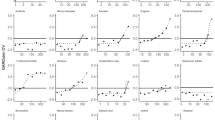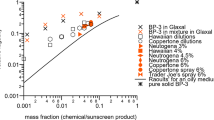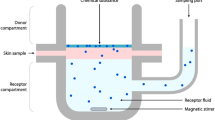Abstract
The results of dermal absorption experiments are routinely and often exclusively reported in terms of fractional absorption. However, fractional absorption is not generally independent of skin loading conditions. As a consequence, experimental outcomes are commonly misinterpreted. This can lead in turn to poor estimation of exposures under field conditions and inadequate threat assessment. To aid interpretation of dermal absorption-related phenomena, a dimensionless group representing the ratio of mass delivery to plausible absorptive flux under experimental or environmental conditions is proposed. High values of the dimensionless dermal number (NDERM) connote surplus supply (i.e., flux-limited) conditions. Under such conditions, fractional absorption will generally depend on load and should not be assumed transferable to other conditions. At low values of NDERM, dermal absorption will be delivery-limited. Under those conditions, high fractional absorption is feasible barring maldistribution or depletion due to volatilization, washing, mechanical abrasion or other means. Similar logic also applies to skin sampling and dermal toxicity testing. Skin surface sampling at low NDERM is unlikely to provide an appropriate measure of potential dermal dose due to depletion, whereas dermal toxicity testing at high NDERM is unlikely to show dose dependence due to saturation.
This is a preview of subscription content, access via your institution
Access options
Subscribe to this journal
Receive 6 print issues and online access
$259.00 per year
only $43.17 per issue
Buy this article
- Purchase on Springer Link
- Instant access to full article PDF
Prices may be subject to local taxes which are calculated during checkout



Similar content being viewed by others
References
Banks Y.B., and Birnbaum L.S. Absorption of 2,3,7,8-tetrachlorodibenzo-p-dioxin (TCDD) after low dose dermal exposure. Toxicol Appl Pharmacol 1991: 107 (2): 302–310.
Brewster D.W., Banks Y.B., Clark A.M., and Birnbaum L.S. Comparative dermal absorption of 2,3,7,8-tetrachlorodibenzo-p-dioxin and three polychlorinated dibenzofurans. Toxicol Appl Pharmacol 1989: 97 (1): 156–166.
Buist H.E., Schaafsma G., and van de Sandt J.J. Relative absorption and dermal loading of chemical substances: consequences for risk assessment. Regul Toxicol Pharmacol 2009: 54 (3): 221–228.
Campbell J.L., Smith M.A., Eiteman M.A., Williams P.L., and Boeniger M.F. Comparison of solvents for removing pesticides from skin using an in vitro porcine model. AIHAJ 2000: 61 (1): 82–88.
Centers for Disease Control and Prevention (CDC). Third National Report on Human Exposure to Environmental Chemicals. CDC, Atlanta (GA), 2005.
Chang S.K., Brownie C., and Riviere J.E. Percutaneous absorption of topical parathion through porcine skin: in vitro studies on the effect of environmental perturbations. J Vet Pharmacol Ther 1994: 17 (6): 434–439.
Cole T.B., Walter B.J., Shih D.M., Tward A.D., Lusis A.J., Timchalk C., Richter R.J., Costa L.G., and Furlong C.E. Toxicity of chlorpyrifos and chlorpyrifos oxon in a transgenic mouse model of the human paraoxonase (PON1) Q192R polymorphism. Pharmacogenet Genomics 2005: 15 (8): 589–598.
Duff R.M., and Kissel J.C. Effect of soil loading on dermal absorption efficiency from contaminated soils. J Toxicol Environ Health 1996: 48 (1): 93–106.
Eaton D.L., Daroff R.B., Autrup H., Bridges J., Buffler P., Costa L.G., Coyle J., McKhann G., Mobley W.C., Nadel L., Neubert D., Schulte-Hermann R., and Spencer P.S. Review of the toxicology of chlorpyrifos with an emphasis on human exposure and neurodevelopment. Crit Rev Toxicol 2008: 38 (Suppl 2): 1–125.
Fenske R.A., Schulter C., Lu C., and Allen E.H. Incomplete removal of the pesticide captan from skin by standard handwash exposure assessment procedures. Bull Environ Contam Toxicol 1998: 61 (2): 194–201.
Fenske R.A., and Lu C. Determination of handwash removal efficiency: incomplete removal of the pesticide chlorpyrifos from skin by standard handwash techniques. Am Ind Hyg Assoc J 1994: 55 (5): 425–432.
Geer L.A., Cardello N., Dellarco M.J., Leighton T.J., Zendzian R.P., Roberts J.D., and Buckley T.J. Comparative analysis of passive dosimetry and biomonitoring for assessing chlorpyrifos exposure in pesticide workers. Ann Occup Hyg 2004: 48 (8): 683–695.
HSRB. April 4–6, 2006 Meeting EPA Human Studies Review Board Report. Memo to G. Gray from C. Fischer. EPA-HSRB-06-01, June 26, 2006.
Hughes M.F., Edwards B.C., Mitchell C.T., and Bhooshan B. In vitro dermal absorption of flame retardant chemicals. Food Chem Toxicol 2001: 39 (12): 1263–1270.
ICRP (International Commission on Radiological Protection). Limits for Intakes of Radionuclides by Workers. ICRP Publication 30. Pergamon Press, Oxford, 1979.
Mage D. Dermal absorption of chlorpyrifos. Ann Occup Hyg 2006: 50 (6): 638–640.
Meuling W.J., Ravensberg L.C., Roza L., and van Hemmen J.J. Dermal absorption of chlorpyrifos in human volunteers. Int Arch Occup Environ Health 2005: 78 (1): 44–50.
Miller M.A., and Kasting G.B. Towards a better understanding of pesticide dermal absorption: diffusion model analysis of parathion absorption in vitro and in vivo. J Tox Env Health Part A 2010: 73: 284–300.
Morgan M.K., Sheldon L.S., Croghan C.W., Jones P.A., Robertson G.L., Chuang J.C., Wilson N.K., and Lyu C.W. Exposures of preschool children to chlorpyrifos and its degradation product 3,5,6-trichloro-2-pyridinol in their everyday environments. J Expo Anal Environ Epidemiol 2005: 15 (4): 297–309.
National Institute for Occupational Safety and Health (NIOSH). NIOSH Pocket Guide to Chemical Hazards. Department of Health and Human Services, Centers for Disease Control and Prevention; Publication No. 2005-149 http://www.cdc.gov/niosh/npg/npgd0137.html, 2005.
National Institute for Occupational Safety and Health (NIOSH) Current Intelligence Bulletin 61: a Strategy for Assigning New NIOSH Skin Notations. Department of Health and Human Services (NIOSH); Publication No. 2009-147. http://www.cdc.gov/niosh/docs/2009-147/, 2009.
Nolan R.J., Rick D.L., Freshour N.L., and Saunders J.H. Chlorpyrifos: pharmacokinetics in human volunteers. Toxicol Appl Pharmacol 1984: 73 (1): 8–15.
ORNL. Data Evaluation Record: Amitraz/106201: Human Tolerance–Dermal; Toxicology and Hazard Assessment Group, Life Sciences Division, Oak Ridge National Laboratory, Oak Ridge TN, EPA Task Order No. 61-2004, August 2004.
Santhanam A., Miller M.A., and Kasting G.B. Absorption and evaporation of N,N-diethyl-m-toluamide from human skin in vitro. Toxicol Appl Pharmacol 2005: 204 (1): 81–90.
Shah P.V., Monroe R.J., and Guthrie F.E. Comparative rates of dermal penetration of insecticides in mice. Toxicol Appl Pharmacol 1981: 59: 414–423.
Spalt E.W., Kissel J.C., Shirai J.H., and Bunge A.L. Dermal absorption of environmental contaminants from soil and sediment: a critical review. J Expo Sci Environ Epidemiol 2009: 19 (2): 119–148.
Thongsinthusak T., Ross J.H., Saiz S.G., and Krieger R.I. Estimation of dermal absorption using the exponential saturation model. Regul Toxicol Pharmacol 1999a: 29 (1): 37–43.
Thongsinthusak T., Ross J.H., and Dong M.H., Significance of Dermal Dose Levels in Dermal Absorption Studies of Pesticides, CA Department of Pesticide Regulation, HS–1801 December 15, 1999b.
Vander A.J., Sherman J.H., and Luciano D.S. Human Physiology: the Mechanisms of Body Function, 4th Ed. McGraw-Hill, New York, 1985.
Zendzian R. Dermal absorption of pesticides in the rat. AIHAJ 2000: 61 (4): 473–483.
Acknowledgements
During preparation of this paper, the author was supported in part by both US EPA ORD through STAR RD-83184401-0 and NIOSH through 2 R01 OH007529-05A1. The material presented here has not been reviewed by either agency and no endorsement should be assumed.
Author information
Authors and Affiliations
Corresponding author
Ethics declarations
Competing interests
The author declares no conflict of interest.
Rights and permissions
About this article
Cite this article
Kissel, J. The mismeasure of dermal absorption. J Expo Sci Environ Epidemiol 21, 302–309 (2011). https://doi.org/10.1038/jes.2010.22
Received:
Accepted:
Published:
Issue Date:
DOI: https://doi.org/10.1038/jes.2010.22



